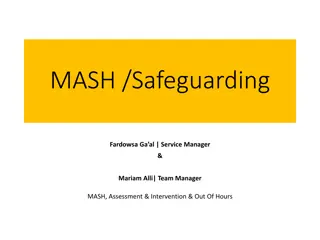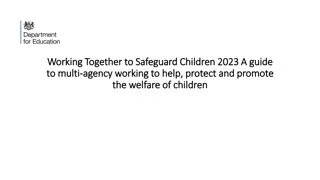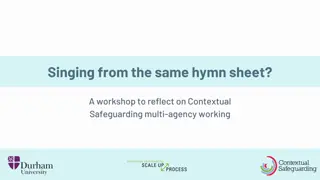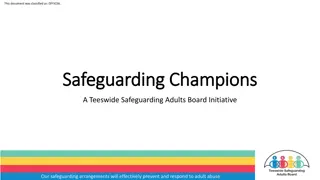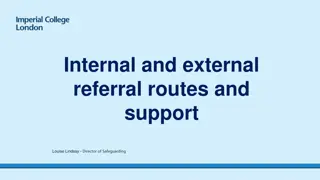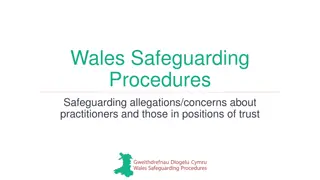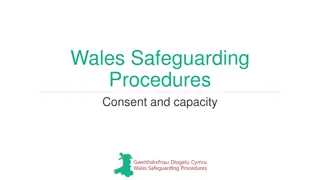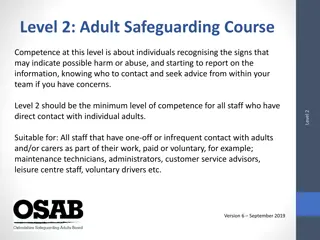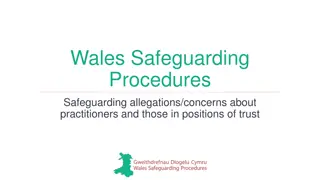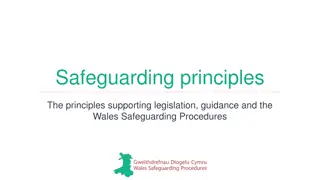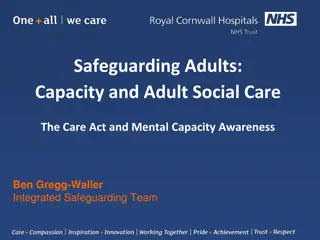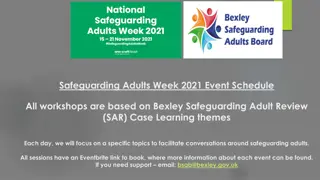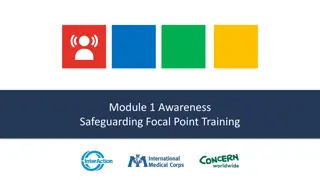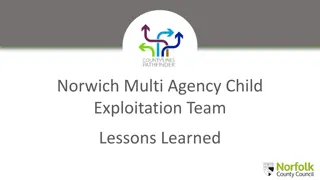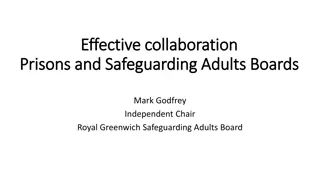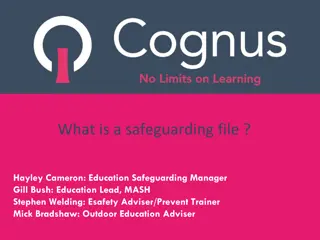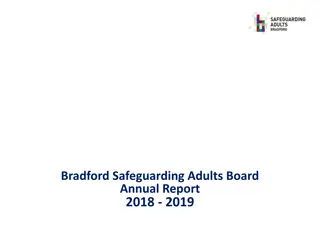Changes to Joint Multi-Agency Safeguarding Adults Policy and Procedures
The changes to the joint multi-agency safeguarding adults policy and procedures in West Yorkshire, North Yorkshire, and the City of York are aimed at enhancing safeguarding practices, implementing new online pathways, and providing resources for staff updates. The focus is on safeguarding adults' right to safety free from abuse and neglect, in line with the Care Act of 2014. Key discussions include the Care Act, making safeguarding personal, new procedures in North Yorkshire, and reporting safeguarding concerns. The Care Act outlines local authorities' duties to investigate and protect adults at risk of abuse or neglect, emphasizing cooperation with relevant partners for adult protection. The statutory S42 enquiry involves a 3-stage test to determine the need for care and support.
Download Presentation

Please find below an Image/Link to download the presentation.
The content on the website is provided AS IS for your information and personal use only. It may not be sold, licensed, or shared on other websites without obtaining consent from the author. Download presentation by click this link. If you encounter any issues during the download, it is possible that the publisher has removed the file from their server.
E N D
Presentation Transcript
Changes to Joint Multi-Agency Safeguarding Adults Policy and Procedures (West Yorkshire, North Yorkshire and City of York) Nicola Webb (Safeguarding Policy and Development Officer, Health and Adult Services) & Haydn Rees Jones (Safeguarding Policy Implementation Officer, Health and Adult Services)
Housekeeping Emergency Procedure Facilities Breaks Communications Equipment Questions Copies of presentation
Aims Give you an outline of the changes to the new multi-agency procedures Changes to the online pathways for the Front Door and through the Customer Service Centre Give you access to resources which can be used to update staff regarding the changes to procedures Preparation for implementation 1stOctober
What we will discuss before break The Care Act Policies and Procedures Key changes Making Safeguarding Personal New North Yorkshire Safeguarding Adults Procedures Stage 1 Reporting a Safeguarding Concern
Safeguarding and the Care Act 2014 Safeguarding means protecting an adult s right to live in safety, free from abuse and neglect. It is about people and organisations working together to prevent and stop both the risks and experience of abuse or neglect, while at the same time making sure that the adult s wellbeing is promoted including, where appropriate, having regard to their views, wishes, feelings and beliefs in deciding on any action. This must recognise that adults sometimes have complex interpersonal relationships and may be ambivalent, unclear or unrealistic about their personal circumstances.
The Care Act (2014) Local Authorities duties and responsibilities Local Authorities must: make enquiries, or cause others to do so, if it believes an adult is experiencing, or is at risk of, abuse or neglect. . An enquiry should establish whether any action needs to be taken to prevent or stop abuse or neglect, and if so, by whom co-operate with each of its relevant partners . in order to protect the adult
Section 42 criteria The 3-Stage test for a Statutory S42 Enquiry:- Has needs for care and support (whether or not the authority is meeting any of those needs), Is experiencing, or is at risk of, abuse or neglect, and As a result of those needs is unable to protect himself or herself against the abuse or neglect or the risk of it.
Non Statutory Safeguarding Enquiries Local authorities are not required by law to carry out safeguarding enquiries on behalf of adults who do not fit the criteria outlined in Section 42 of the Care Act 2014; they do so at their own discretion. These enquiries would relate to an adult who: Is believed to be experiencing, or is at risk of, abuse or neglect; and Does not have care and support needs (but might have just support needs). Within the scope of this definition are: Adults who manage their own care and support through personal or health budgets; Adults whose needs for care and support have not been assessed as eligible or which have been assessed as below the level of eligibility for support; Adults who fund their own care and support; Young people Carers
Care Act 2014 Local Authorities must also co-operate with such other agencies or bodies as it considers appropriate in the exercise of its adult safeguarding functions, including: General Practitioners Dentists Pharmacists NHS hospitals, and Housing, health and care providers Safeguarding is a statutory requirement and all organisation must follow the policies and procedures provided by the Board
Review of agreed Multi-Agency Policy and Procedures Seven Safeguarding Adults Boards worked together to review the Multi-Agency Safeguarding Adults Policy and Procedure, this included: Bradford, Calderdale, Kirklees, Leeds, York, Wakefield and North Yorkshire
Review of Safeguarding Policy and Procedures The current version of the Policy and Procedures was launched when the Care Act was implemented New statutory guidance in 2016 highlighted the need for Making Safeguarding Personal and changes to responding to self-neglect There was also the need to strengthen the Community Safety Partnership Agenda, including Prevent, Modern Slavery and Domestic Abuse There was an increased need to examine and reduce the number of non- safeguarding referrals received through the safeguarding process A further review has taken place to ensure the procedures deliver an effective, proportionate, person centred approach that supports people to be safe and promotes their wellbeing
Key changes Focusing on the adult and their desired outcomes in relation to involving and supporting the adult at risk in the context of Making Safeguarding Personal (MSP) Ensure risk is assessed Introducing role of Safeguarding Concerns Manager (formerly Responder, for provider organisations) Its not about an investigation to substantiate abuse on the balance of probability Making it a more simple process which is less bureaucratic Having a single pathway with flexible person centred responses providing a clearer process for practitioners to follow, and make it easier for members of the public to understand what will happen in relation to their concerns.
The old and the new Process up to 30 September 2019 Process from 1 October 2019 1. Raising a Concern 1. Reporting a Concern 2. Initial enquiries 2. Responding to a concern / Information Gathering 3. Risk Management Response 4. Strategy Meeting 3. Safeguarding Response 5. Formal Enquiry 6. Case conference 4. Outcomes and Closure 7. Review
The Experience of the Adult at Risk and procedures 3. We will take agreed actions to support you to be safe 4. We will check that we have addressed your concerns 2. We will consider how best to help you 1.Tell us your concern Experience of the Adult at Risk Responding to the Concern/Information Gathering Outcomes and Closure (Including Plan and Review) Reporting a Concerns Safeguarding Response Procedures to deliver Safeguarding
Making Safeguarding Personal (MSP) Keeping the person and their wishes and desired outcome at the centre of any safeguarding enquiry When raising a concern, ask the person what outcome they would like to achieve through safeguarding or what would help them feel safer Promoting positive risk taking and supporting people s choice and control Support people who lack capacity to make their own decisions with the least restrictive option Seeking to enable people to resolve their circumstances, recover from abuse or neglect and realise the outcomes that matter to them in their life Statutory services Local services and providers The community Family and friends Adult at risk
Making Safeguarding Personal AT THE END OF THE ENQUIRY THE PERSON SHOULD BE ABLE TO SAY . People worked together reducing risk to my safety and well-being The people I wanted were involved People I had the information I needed in the way I needed it I was helped to manage the risks I had good quality care I felt safe and in control understood me and recognised what I could do
A new approach We have reviewed and improved pathways through the Customer Service Centre including: Reporting safeguarding concerns Requests for assessment/services and Reporting Risk Notifications Returns Professionals following the correct pathway will ensure a timely response from Health and Adult Services
Request for assessment of need Where an adult may have needs for care and support, the authority must assess whether the adult does have needs for care and support, and if the adult does, what those needs are. Any requests for assessment of need will require: Personal details including name, date of birth, age, full address, GP The person s consent
Risk Notification Return For Care Providers ONLY The Safeguarding Decision Support Guidance assist Providers in identifying situations that may occur whilst carrying out a Regulated service/activity that requires notification to the Quality & Market Improvement team via completion of the Risk Notification Return; or this may be within an unregulated activity such as day support service. This is to encourage a culture of openness and transparency within health and social care services at all levels within organisations.
Risk Notification Return For Care Providers ONLY The Risk Notification Return will ensure that the situation is reported, internal learning is captured and shared, to prevent recurrence and escalation. There is a tool to support decision making, it helps to: Support proportionate reporting of safeguarding concerns Support reporting of Risk Notification Returns to the Quality and Market Improvement Team i.e. issues that are not safeguarding It does not replace professional judgment or statutory notifications (CQC) The Risk Notification Return does not need to be completed if a CQC notification form has been completed.
Safeguarding Adults Decision Support Guidance The guidance covers: Falls Incidents between adults at risk Nutrition and hydration Pressure area care Missed home care visit Medication errors Moving and handling Poor discharge Financial concerns Environmental issues A number of these may be more appropriately reported as a Risk Notification Returns
Risk Notification Returns Pilot was completed within Health and Adult Services with in- house Provider Services and a pilot with independent and private providers was undertaken It has been agreed to roll this out to those organisation carrying out a regulated service/activity or an unregulated activity such as day support service Extended county wide from 1 October 2019
Terminology Terminology Meaning Safeguarding concern Concerns relating to an adult at risk of abuse or neglect Adult at risk This is the adult at risk and the centre of the safeguarding enquiry Person Alleged to have Caused Harm (PATCH) The person who is reported to have caused harm to an individual this may also be an organisation Safeguarding Concerns Manager The person with safeguarding responsibilities within an organisation who raised a safeguarding concern to the Local Authority (formerly Responder) Safeguarding Coordinator The Safeguarding Coordinator manages the overall safeguarding function within Local Authority Enquiry Officer Is either a Social worker or Occupational Therapist who is responsible for undertaking enquiries on the behalf of the Local Authority
Terminology Terminology Meaning Enquiry There are two types of safeguarding enquiry, either: Section 42 criteria Safeguarding Other - Non-statutory enquiry Planning discussion This may be a face to face, telephone or video conversation with Enquiry Officer, person and/or their representative/advocate which is an informal response. Planning meeting This is a multi-agency meeting which is chaired by the Safeguarding Coordinator for the relevant locality team (Independence, Planned Care, Mental Health or Sensory Service) - This is a Formal Response
Terminology Terminology Meaning Keeping Safe Plan (Formerly Safeguarding Plan) This includes: Steps to assure future safety Provision of any support, treatment or therapy (including on-going advocacy) Modifications to service provision Support required through any action to seek justice or redress Any steps that the person can take to keep themselves safe Outcome Review This may be undertaken over the phone or a by a meeting being convened with the Safeguarding Coordinator
Stage One Raising a concern
Care Act guidance - roles and responsibilities in safeguarding enquiries Each organisation should have safeguarding adults policies and procedures. These should: Reflect the statutory guidance as outlined in the Joint Safeguarding Adults Multi-Agency Policy and Procedures (West Yorkshire, North Yorkshire and the City of York) Support the reduction or removal of safeguarding risks, as well as to secure any support to protect the person To help the person recover and develop resilience. This, in turn will encourage a proportionate response and improve outcomes for the person concerned.
Categories of abuse under the Care Act Discriminatory Abuse Domestic Abuse Financial and Material Abuse Modern Slavery Neglect and Acts of Omission Organisational Abuse Physical Abuse Psychological Abuse Self-Neglect Sexual Abuse
Self-Neglect Self-neglect involves situations where a person is placing themselves at risk of harm. This could be due to their reluctance, or inability to accept the assistance they need with their care and support needs. The Care Act Statutory Guidance (2016) contains additional advice concerning self-neglect suggesting that it: May not prompt a section 42 enquiry. An assessment should be made on a case by case basis. A decision on whether a response is required under safeguarding will depend on the adult s ability to protect themselves by controlling their own behaviour. There may come a point when they are no longer able to do this, without external support.
Responding to Self-Neglect In some cases it is appropriate for Section 42 enquiry if it meets the criteria In most cases Section 42 enquiry is not an appropriate response A joint protocol with City of York is being developed to respond to concerns raised regarding Self-Neglect and Hoarding Information will be available from the NYSAB website when launched
Prevent Duty A Prevent referral should be made if there is a reason to suspect the individual is engaged in, is drawing others in, or may be at risk from radicalisation or extremism There is additional guidance available when a concern is being reported to ensure the police have all the information required to make a full assessment, including: Vulnerabilities Associations Ideology Internet and Social Media Suspicious Travel Grievance Consent is not required
Considerations if a disclosure is made to you, or you suspect abuse Immediate risk to a person with care and support needs and/or others Mental Capacity What does the person want to happen? Confidentiality? Being honest and clear about the action you are going to take and why Consider whistleblowing procedures Refer a concern to the local authority is required if abuse is known or suspected Consider if a crime needs to be reported and you have the adults consent to do so Record all conversations and actions taken
: Managing Safeguarding Concerns Flowchart You are informed/become aware of possible abuse or neglect Managing a Safeguarding Concern Gather info, including desired outcomes of adult, to inform your decisions Take action to ensure immediate safety/welfare of adult & any other person at risk. Consider: Is urgent medical attention/ambulance required? (dial 999) Is an urgent Police presence required? (dial 999) Does a crime need to be reported & do I have adult s consent to do so? (dial 101 unless immediate risk, in which case dial 999) Be aware of poss. need to preserve forensic evidence Decide whether to raise a s/g concern & if so, take action. Do this: Immediately where concern is urgent/serious Within the same working day for any other concerns Document incident & any actions/decisions taken Ensure key people informed e.g. CQC, relatives as appropriate, contracting
Stage 1: Adult Safeguarding Procedures Ask the person what they want to achieve through safeguarding (Making Safeguarding Personal) Consent and Mental Capacity Record issues and actions taken to reduce risk Raise a concern within 24 hours
Putting the person at the centre of the concern Making Safeguarding Personal (MSP) starts before the concern is raised with the local authority Organisations should ensure their procedures: Help the person to resolve their circumstances, recover from abuse or neglect and realise the outcome(s) based on their views and wishes Talk to the person, listen to what outcome they would like to achieve and what would help them feel safer now Having proportionate risk appraisal which includes positive risk assessment to support the person to achieve the person s outcome Any risk assessment being undertaken needs to be shared when reporting a concern
Decision Making Flowchart All adults should be presumed to have capacity unless an assessment of capacity has shown that a person does not in line with the MCA. If the person is capable, consent must be obtained by the person undertaking the procedure Can the person make the required decision. Do they need additional support, more time and to be given the information in a different format or asked at a more appropriate time? The person will be able to decide Yes Unclear Conduct the two-stage capacity test No The person will be able to decide Does the person have capacity to make the decision required? Yes No Refer to the Mental Capacity Act (2005) decision making Refer to the five principles of the MCA: Assume a person has capacity Support the individual to make their own decision Someone may make an unwise decision Always act, or decide, for a person without capacity in their best interests Choose the least restrictive option
Raising a concern without consent When you raise a safeguarding concern you need to check with the adult at risk if they give consent for you to do so Sometimes it is necessary to raise a safeguarding concern even if it is contrary to the wishes of the person. You should consider: Is it in the public interest? e.g. there is also a risk to others, a member of staff or volunteer is involved, or the abuse has occurred on property owned or managed by an organisation with a responsibility to provide care Does the person understand what has happened to them as in relation to the safeguarding incident. Have they been assessed and do they lack mental capacity to consent? Is it in the person s best interests? Does the person already have an advocate? Is the person subject to coercion or undue influence, to extent that they are unable to give consent? Is it in the person s vital interests (to prevent serious harm or distress or life threatening situations)? Duty of care for provider organisations and for those working with adults
Key questions when deciding whether to report a safeguarding concern Safeguarding Concerns Manager
Provider Duties Where a member of staff is alleged to have caused harm to an adult at risk, the organisation should: Take appropriate action to ensure the safety and wellbeing of the adult at risk Support both the adult at risk and the member of staff Follow their managing allegations against staff procedures Employers should: Dealing with employment/disciplinary issues; Protecting the person whom the concern is about; Incident investigation; Assuring regulators and commissioners; Preventing recurrent risk, and risk to others; Reporting concerns. Organisations should have in place procedures for managing allegations against staff The adult should always be involved from the beginning of the enquiry unless there are exceptional circumstances that would increase the risk of abuse.
Documenting the incident, actions and decisions Defensible recording Ensure that contemporaneous record are kept, including details of: The nature of the safeguarding concern/allegation The wishes and desired outcomes of the person The support and information provided to enable the person to make an informed decision An assessment of mental capacity, where indicated The decision of the organisation to raise a safeguarding concern (or not) Any original records made in the context of the above must be kept safely in case they are required at a later date by Police Assessment of risk and actions taken to reduce or manage risk
Raising a concern If the person you are concerned about is not in immediate danger, you should report the concern to the Local Authority via the Customer Service Centre This is presently being developed but you will also be able to access the link from: https://safeguardingadults.co.uk/working-with-adults/raising-a-concern
Break 15 minutes
Stage 2 Responding to the concern/information gathering Stage 3 Safeguarding response Stage 4 Outcome and closure including plan and review NYSAB Website Tool Kit Questions
Stage Two Responding to a concern/information gathering
Receipt of a Concern Safeguarding concerns will be received within the Customer Service Centre (CSC) Specialist Advisor in the CSC will triage the concern form, the day it is received The Specialist Advisor will contact the person referring the concern where: Where there is a need to clarify points raised in the concern and what actions have been taken to manage risk, or Additional information is required, or To establish if an additional/alternative service is required. There is a need to verify if there is consent to share personal information.
Safeguarding Enquiry The Specialist Advisor will establish if the concern raised appears to meet : s42 criteria , i.e. Does the person appear to have care and support needs Does the person appear to be at risk of or experiencing abuse or neglect? Does the person appear to be unable to protect themselves from harm as a result of their care and support needs? Or Safeguarding other Is the person experiencing or at risk of abuse or neglect? The person does not have care and support needs but has support needs Does the person or others appear to be at risk of harm? Prevent Duty Will be progressed to the police under safeguarding in North Yorkshire
Customer Service Centre Specialist Advisor receives concern Concern does not meet Section 42 or Safeguarding Other criteria Concern appears to meet Section 42 criteria or Safeguarding Other Case closed to safeguarding and passed for either a request for service, provision of information, advice and guidance, signpost to another agency or no further action Care and Support Team Locality Team
Care and Support Team (Customer Service Centre) When a (unknown or known closed) case is received by the Care and Support Team the Safeguarding Coordinator is responsible for allocating the case to an Enquiry Officer The Enquiry Officer is responsible for: Responding to the concern Information gathering and Coordinating the response to assess immediate risk on the same working day it is received by the Care and Support Team The Enquiry Officer will make a recommendation to the Safeguarding Coordinator about what action should be taken Cases will be reassigned to locality teams where: The adult at risk cannot be contacted, or A planning meeting or discussion is required
Locality Teams For decisions about which locality team would receive the case the following should be considered;- Moving and handling issues identified may be managed by Independence. For cases which are multi-agency, or where there is a criminal element identified or where the enquiry is likely to be long or complex and where organisational abuse is identified may be managed by Planned Care When organisational abuse is indicated this must be discussed with a Safeguarding Coordinator The response should be proportionate to the concern and consideration of risk to other people who may be using the service.


